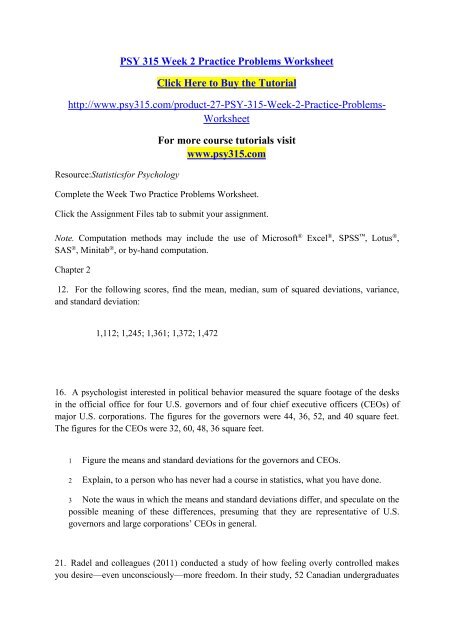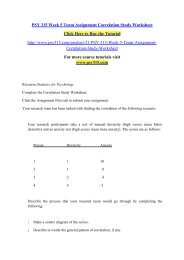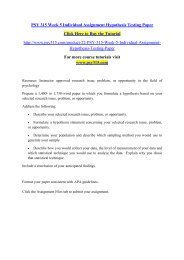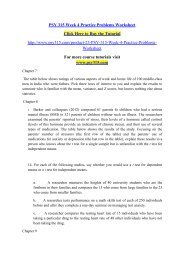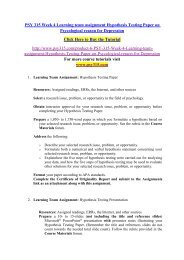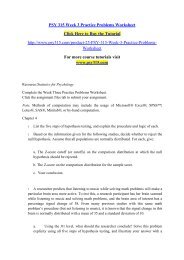PSY 315 Week 2 Practice Problems Worksheet
For more course tutorials visit www.psy315.com Resource:Statisticsfor Psychology Complete the Week Two Practice Problems Worksheet. Click the Assignment Files tab to submit your assignment. Note. Computation methods may include the use of Microsoft® Excel®, SPSS™, Lotus®, SAS®, Minitab®, or by-hand computation. Chapter 2 12. For the following scores, find the mean, median, sum of squared deviations, variance, and standard deviation: 1,112; 1,245; 1,361; 1,372; 1,472
For more course tutorials visit
www.psy315.com
Resource:Statisticsfor Psychology
Complete the Week Two Practice Problems Worksheet.
Click the Assignment Files tab to submit your assignment.
Note. Computation methods may include the use of Microsoft® Excel®, SPSS™, Lotus®, SAS®, Minitab®, or by-hand computation.
Chapter 2
12. For the following scores, find the mean, median, sum of squared deviations, variance, and standard deviation:
1,112; 1,245; 1,361; 1,372; 1,472
- No tags were found...
You also want an ePaper? Increase the reach of your titles
YUMPU automatically turns print PDFs into web optimized ePapers that Google loves.
<strong>PSY</strong> <strong>315</strong> <strong>Week</strong> 2 <strong>Practice</strong> <strong>Problems</strong> <strong>Worksheet</strong><br />
Click Here to Buy the Tutorial<br />
http://www.psy<strong>315</strong>.com/product-27-<strong>PSY</strong>-<strong>315</strong>-<strong>Week</strong>-2-<strong>Practice</strong>-<strong>Problems</strong>-<br />
<strong>Worksheet</strong><br />
Resource:Statisticsfor Psychology<br />
For more course tutorials visit<br />
www.psy<strong>315</strong>.com<br />
Complete the <strong>Week</strong> Two <strong>Practice</strong> <strong>Problems</strong> <strong>Worksheet</strong>.<br />
Click the Assignment Files tab to submit your assignment.<br />
Note. Computation methods may include the use of Microsoft ® Excel ® , SPSS , Lotus ® ,<br />
SAS ® , Minitab ® , or by-hand computation.<br />
Chapter 2<br />
12. For the following scores, find the mean, median, sum of squared deviations, variance,<br />
and standard deviation:<br />
1,112; 1,245; 1,361; 1,372; 1,472<br />
16. A psychologist interested in political behavior measured the square footage of the desks<br />
in the official office for four U.S. governors and of four chief executive officers (CEOs) of<br />
major U.S. corporations. The figures for the governors were 44, 36, 52, and 40 square feet.<br />
The figures for the CEOs were 32, 60, 48, 36 square feet.<br />
<br />
<br />
Figure the means and standard deviations for the governors and CEOs.<br />
Explain, to a person who has never had a course in statistics, what you have done.<br />
Note the waus in which the means and standard deviations differ, and speculate on the<br />
possible meaning of these differences, presuming that they are representative of U.S.<br />
governors and large corporations’ CEOs in general.<br />
21. Radel and colleagues (2011) conducted a study of how feeling overly controlled makes<br />
you desire—even unconsciously—more freedom. In their study, 52 Canadian undergraduates
played a video game in a laboratory and were randomly assigned to either:<br />
a. anautomony deprivation condition, in which they were told to follow instructions<br />
precisely, constantly given instructions over a loudspeaker, and carefully observed on<br />
everything they did.<br />
b. a neutral condition, which was much more laid back.<br />
After this activity, they were asked to do a “lexical decision task” (a standard approach<br />
for measuring unconscious responses) in which they were shown a series of words and<br />
nonwords in random order and had to press “C” if it was a real word or “N” if not. Half of<br />
the real words were related to autonomy (e.g., freedom, choice) and half were neutral<br />
(e.g., whisper, hammer). The key focus of the study was on how long it took people to<br />
press the button *(“response latency”) for each kind of real word, averaged over the many<br />
words of each type. The table below shows the mean and standard deviation across the<br />
participants of these four categories of results. Thus, for example, 782 milliseconds<br />
(thousandths of a second) is the average time it took participants in the autonomydeprived<br />
condition to respond to the autonomy-related words, and 211 is the standard<br />
deviation across the 26 participants’ average response time in that condition. Explain the<br />
numbers in this table to a person who has never had a course in statistics. (Be sure to<br />
explain some specific numbers, as well as the general principle of the mean and standard<br />
deviation.) For your interest, the pattern of results shown here supported the researchers’<br />
hypothesis: “Relative to a neutral instructional climate, a controlling climate thwarting the<br />
need for autonomy…enhanced accessibility for autonomy-related words.” (p.924).<br />
Chapter 3<br />
14. On a standard measure of hearing ability, the mean is 300 and the standard deviation is<br />
20. Give the raw scores for persons whose Z scores for persons who score 340, 310, and 260.<br />
Give the raw scores for persons whose Z scores on this test are 2.4, 1.5, and -4.5.<br />
16. The amount of time it takes to recover physiologically from a certain kind of sudden<br />
noise is found to be normally distributed with a mean of 80 seconds and a standard deviation<br />
of 10 seconds. Using the 50%–34%–14% figures, approximately what percentage of scores<br />
(on time to recover) will be:<br />
Above 100?<br />
Below 100?<br />
Above 90?<br />
Below 90?
Above 80?<br />
Below 80?<br />
Above 70?<br />
Below 70?<br />
Above 60?<br />
Below 60?<br />
18. Suppose that the scores of architects on a particular creativity test are normally<br />
distributed. Using a normal curve table, what percentage of architects have Z scores:<br />
Above .10?<br />
Below .10?<br />
Above .20?<br />
Below .20?<br />
Above 1.10?<br />
Below 1.10?<br />
Above -.10?<br />
Below -.10?<br />
21. Suppose that you are designing an instrument panel for a large industrial machine. The<br />
machine requires the person using it to reach 2 feet from a particular position. The reach from<br />
this position for adult women is known to have a mean of 2.8 feet with a standard deviation<br />
of .5. The reach for adult men is known to have a mean of 3.1 feet with a standard deviation<br />
of .6. Both women’s and men’s reach from this position is normally distributed. If this design<br />
is implemented:<br />
What percentage of women will not be able to work on this instrument panel?<br />
What percentage of men will not be able to work on this instrument panel?<br />
Explain your answers to a person who has never had a course in statistics.
24. Suppose that you were going to conduct a survey of visitors to your campus. You want<br />
the survey to be as representative as possible.<br />
How would you select the people to survey?<br />
Why would that be your best method?


